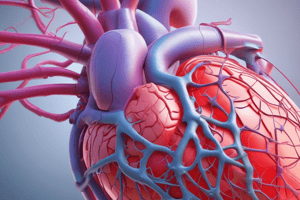Podcast
Questions and Answers
What occurs due to pressure overload, such as aortic stenosis, in terms of ventricular response?
What occurs due to pressure overload, such as aortic stenosis, in terms of ventricular response?
- Concentric hypertrophy without dilation to normalize stress. (correct)
- Increased end-diastolic volume with resultant dilation.
- Eccentric hypertrophy leading to decreased wall stress.
- Decreased tension and increased afterload due to lower wall thickness.
What is the primary pathological effect of mitral valve stenosis on left ventricular filling?
What is the primary pathological effect of mitral valve stenosis on left ventricular filling?
- Increased stroke volume due to enhanced filling pressure.
- Improved compliance of the left atrium.
- Reduced stroke volume due to restricted filling. (correct)
- Increased ejection fraction despite lower volume.
Which mechanism primarily influences late ventricular filling during strenuous exercise?
Which mechanism primarily influences late ventricular filling during strenuous exercise?
- Reduced venous return due to increased intrathoracic pressure.
- Increased heart rate due to sympathetic activity.
- Prolonged diastole from bradycardia.
- Atrial contraction becoming more significant. (correct)
During acute mitral valve insufficiency, which of the following changes occurs first?
During acute mitral valve insufficiency, which of the following changes occurs first?
What effect does a faster heart rate have on diastolic and systolic periods?
What effect does a faster heart rate have on diastolic and systolic periods?
Which of the following best describes the consequence of cardiac hypertrophy on stroke volume over time?
Which of the following best describes the consequence of cardiac hypertrophy on stroke volume over time?
What does the Law of Laplace define in the context of cardiac function?
What does the Law of Laplace define in the context of cardiac function?
What is a typical result of left atrial enlargement in chronic mitral valve insufficiency?
What is a typical result of left atrial enlargement in chronic mitral valve insufficiency?
How does increased contractility through sympathetic activity affect myocardial cells?
How does increased contractility through sympathetic activity affect myocardial cells?
What characterizes the isovolumetric contraction period in cases of heightened left ventricular volume due to regurgitation?
What characterizes the isovolumetric contraction period in cases of heightened left ventricular volume due to regurgitation?
Flashcards are hidden until you start studying
Study Notes
Cardiac Function and Adaptations
- Changes in the right ventricle influence the left ventricle, especially during short delays.
- Atrial stretch is a significant factor during strenuous exercise.
- In athletes, pathologically slow heart rates lead to prolonged filling times, resulting in increased end-diastolic volume (EDV).
Role of Atria in Exercise
- During rapid heart rates, diastole shortens more than systole, making atrial contraction crucial for late ventricular filling.
Determinants of Heart Performance
- Afterload: Formal definition is wall stress, which is linked to aortic pressure.
- Autonomic Changes: Affect blood pressure (BP), heart rate, and contractile force; drugs can induce changes in aortic pressure.
Law of Laplace
- Wall tension can be expressed as Tension = Ventricular pressure x Wall thickness.
Types of Cardiomyopathy
- Concentric Hypertrophy: Resulting from pressure overload (e.g., aortic stenosis) leads to increased wall thickness without dilation.
- Eccentric Hypertrophy: Associated with volume overload (e.g., aortic or mitral insufficiency); characterized by increased EDV and dilation.
Heart Failure and Cardiac Pathophysiology
- Heart failure can be left-sided or right-sided, and is often due to valve disorders, cardiac hypertrophy, or myocardial infarctions.
- Myocardial ischemia and rhythm disorders can exacerbate cardiac hypertrophy.
Pathological Effects of Mitral Valve Disorders
- Mitral Valve Stenosis: Results in restrictive filling and increases left atrial pressure.
- Mitral Valve Insufficiency: Causes regurgitation, leading to volume overload and distended left ventricle with increased EDV.
Related Pathological Outcomes
- Aortic stenosis and insufficiency cause pressure overload and volume overload, respectively, leading to ventricular dilation and end-diastolic pressure elevation.
- Cardiomyopathies can be classified into hypertrophic, dilated, and restrictive types, with varied causes including genetic, inflammatory, and toxic factors.
Myocardial Infarction Effects
- Damage from myocardial infarction results in non-functional wall segments, hypertrophy of viable myocardium, increased EDV, and reduced ejection fraction.
Heart Failure Mechanisms
- Heart failure is defined by the heart's inability to adequately pump blood, commonly linked to decreased systolic function.
- Two main types: Systolic (failure of contraction) and Diastolic (failure of relaxation).
- Right-sided failure can lead to systemic edema, while left-sided failure typically causes pulmonary congestion.
JVP Changes in Heart Failure
- Contributes to diagnosing heart failure by indicating elevated pressures in the atria.
Clinical Correlations
- Renin Production: In heart failure, there is an increase in renin production due to decreased cardiac output.
- Sympathetic Nervous System Drive Decrease: Can occur in acute heart failure, leading to physiological changes in cardiac performance.
Summary of Revision Questions
- Q1: Transition from standing to supine increases venous return and EDV; decreases HR.
- Q2: Pathological conditions represented by altered pressure-volume (P-V) loops include myocardial infarction and valve disorders.
- Q3: Acute heart failure is characterized by increased renin production, with a cascade of neuro-humoral changes.
These notes encapsulate the complexities of cardiac function, adaptations, and the implications of various pathological states, especially in terms of heart failure and function.
Studying That Suits You
Use AI to generate personalized quizzes and flashcards to suit your learning preferences.




